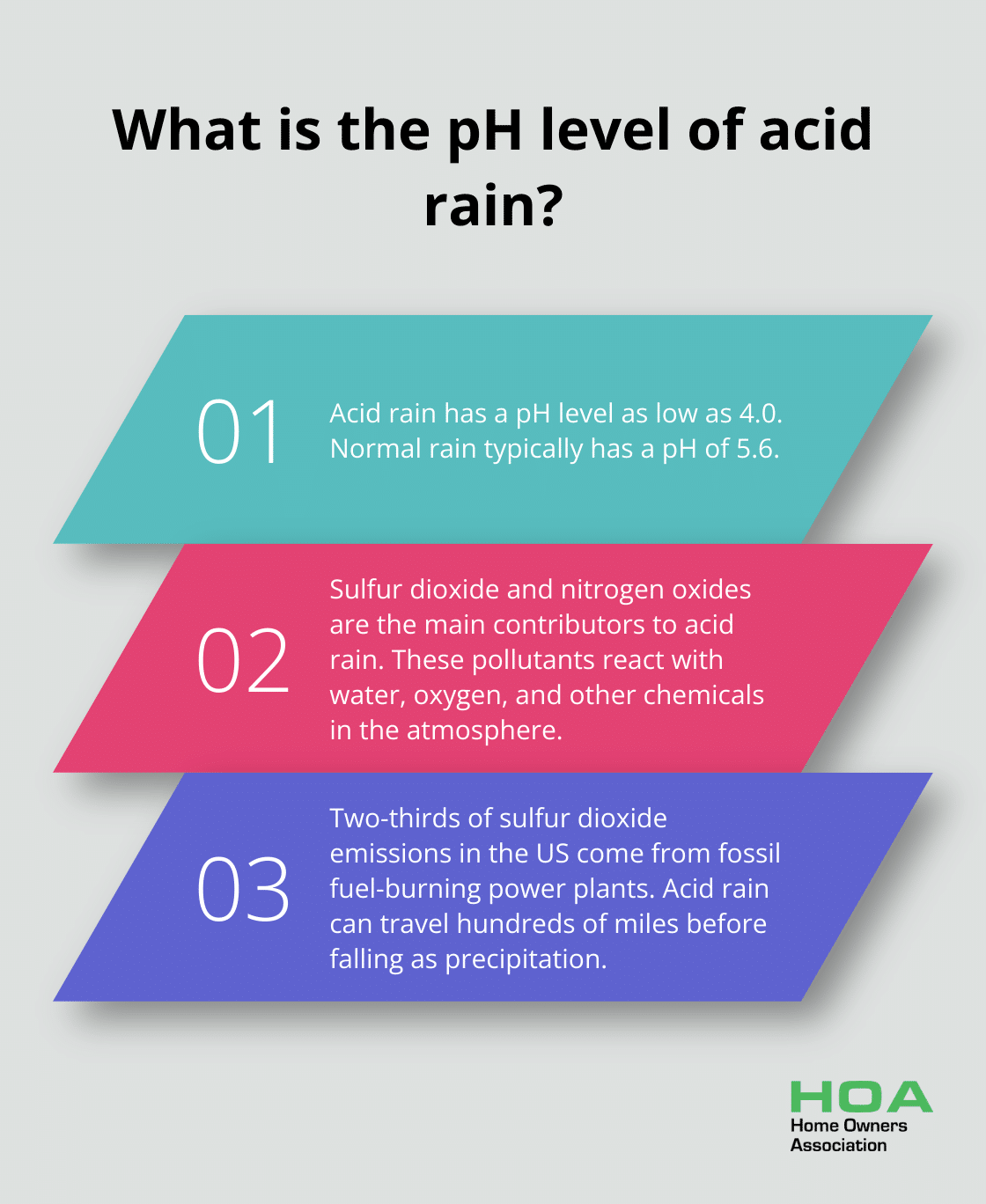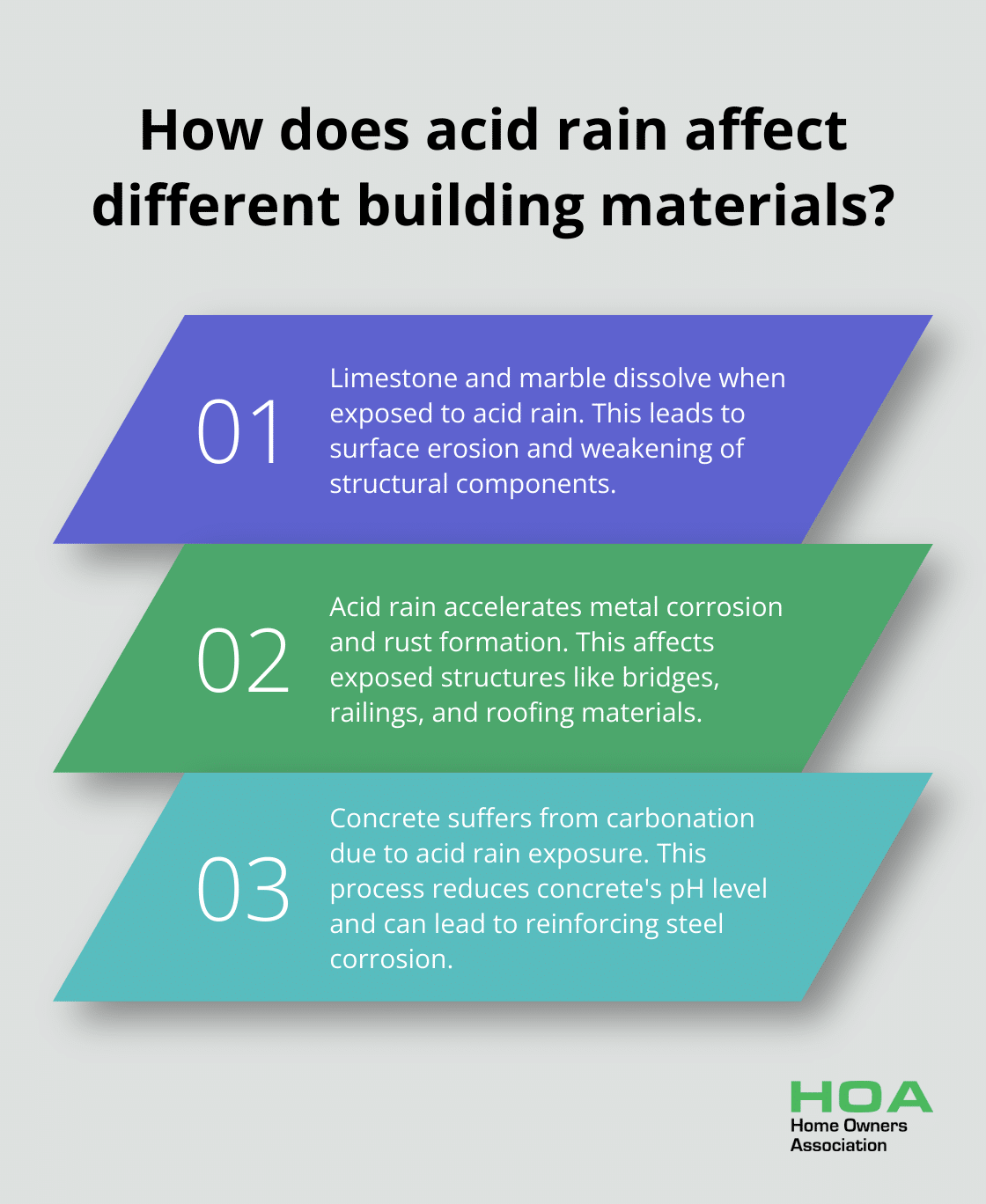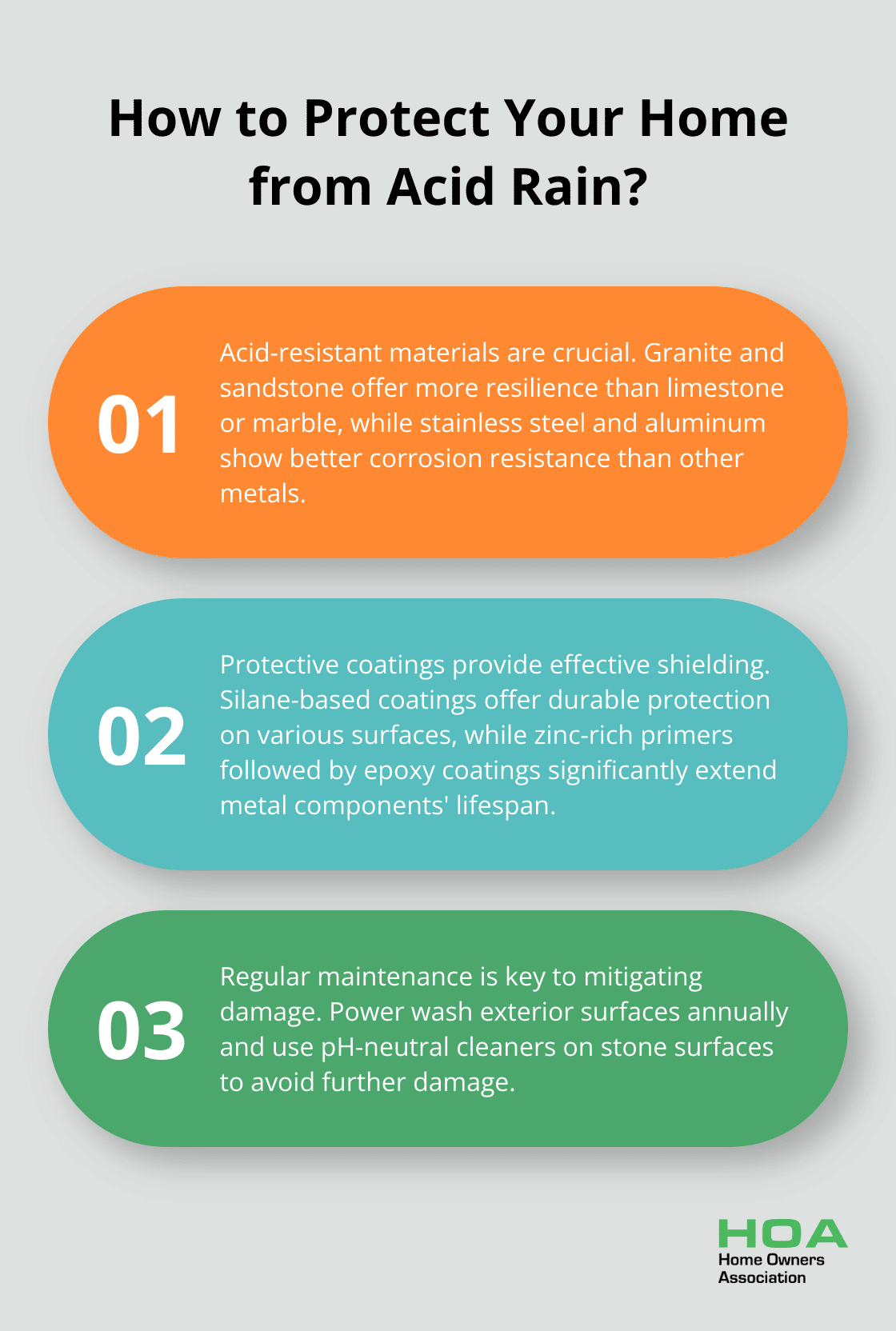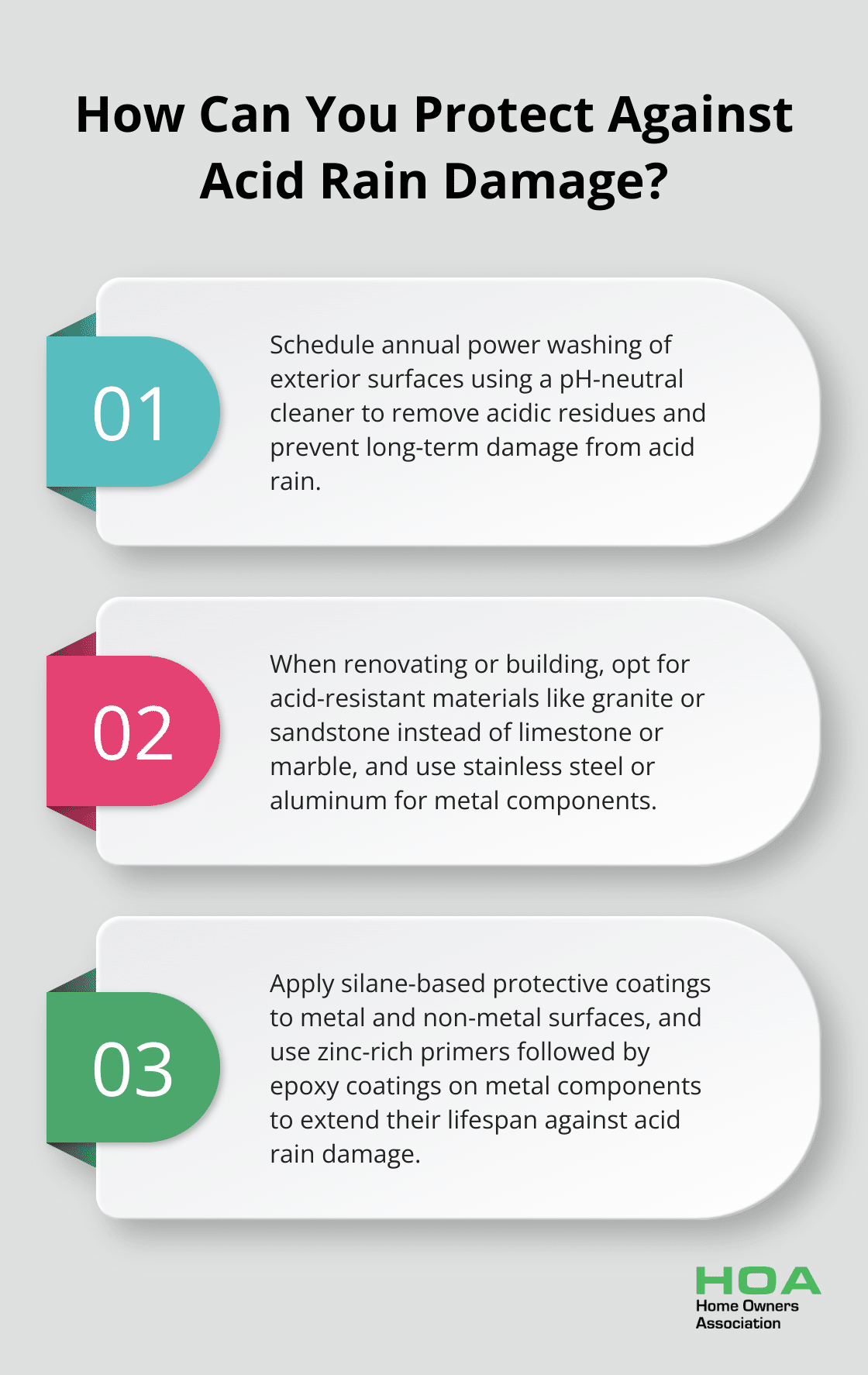
At Home Owners Association, we often field questions about how environmental factors impact our homes. One common concern is the effect of acid rain on building materials.
Acid rain, a result of both natural processes and human activities, can significantly damage various construction components over time. Understanding how acid rain affects building materials is essential for homeowners to protect their investments and maintain their properties effectively.
What Is Acid Rain and How Does It Form?
Definition of Acid Rain
Acid rain is caused by the release of sulfur dioxide and nitrogen oxides into the atmosphere, where they react with water, oxygen, and other chemicals. This mixture falls to the ground as rain, snow, or fog, carrying a higher acidity level than normal precipitation. The pH level of acid rain can be as low as 4.0, compared to the typical 5.6 pH of normal rain.
Sources of Acid Rain
While some acid rain occurs naturally due to volcanic eruptions or decaying vegetation, human activities are the primary culprits. Industrial processes, power plants, and vehicle emissions release sulfur dioxide and nitrogen oxides into the atmosphere. These pollutants react with water, oxygen, and other chemicals to form sulfuric and nitric acids.

The Environmental Protection Agency (EPA) reports that about two-thirds of sulfur dioxide emissions in the United States come from fossil fuel-burning power plants. This statistic highlights the significant impact of energy production on acid rain formation.
Chemical Composition and Its Effects
The main components of acid rain are sulfuric and nitric acids. These acids can travel long distances (sometimes hundreds of miles) before falling as precipitation. This means that areas far from pollution sources can still experience the effects of acid rain.
The National Atmospheric Deposition Program (NADP) monitors acid rain levels across the country. Their data shows that while acid rain levels have decreased since the 1990s due to regulations, it remains a concern in many areas, particularly in the northeastern United States.
Impact on Building Materials
The corrosive nature of acid rain makes it a significant concern for homeowners. The acidic particles in rain can accelerate the weathering of building materials. For instance, limestone and marble (common in many structures) are particularly vulnerable. When sulfurous, sulfuric, and nitric acids in polluted air and rain react with the calcite in marble and limestone, the calcite dissolves.
Homes in areas with high industrial activity or near coal-burning power plants face greater risk. Homeowners in these regions should prioritize protecting their properties from acid rain damage.
As we move forward, we’ll explore the specific effects of acid rain on various building materials and discuss strategies to mitigate its impact.
How Acid Rain Damages Building Materials
Acid rain poses a significant threat to various building materials, causing gradual deterioration that can lead to costly repairs and compromised structural integrity. We will explore how acid rain impacts different construction materials.
Limestone and Marble: The Silent Victims
Limestone and marble, popular choices for their aesthetic appeal, are particularly vulnerable to acid rain damage. When sulfurous, sulfuric, and nitric acids in polluted air react with the calcite in marble and limestone, the calcite dissolves. This process can lead to surface erosion, loss of detail on decorative elements, and weakening of structural components.

The U.S. Geological Survey has conducted studies on the effects of acid rain on marble samples at various research sites. While specific rates of deterioration may vary, these studies highlight the significant impact of acid rain on limestone and marble structures.
Metal Corrosion: A Rust-y Situation
Metals used in construction, such as steel and copper, are not immune to acid rain’s effects. The acidity accelerates the oxidation process, leading to faster corrosion and rust formation. This is particularly problematic for exposed metal structures like bridges, railings, and roofing materials.
Concrete Concerns: More Than Surface Deep
Concrete, a staple in modern construction, is also affected by acid rain. The acidic compounds can react with the cement paste in concrete, leading to a phenomenon called carbonation. This process reduces the concrete’s pH level, potentially exposing reinforcing steel to corrosion.
Moreover, acid rain can leach calcium from concrete, weakening its structure over time. This is particularly concerning for infrastructure like bridges and parking structures, where structural integrity is paramount.
Wood and Paint: The Overlooked Victims
Wood and paint are also susceptible to acid rain damage. Acidic precipitation can accelerate the breakdown of paint, leading to peeling and discoloration. This not only affects the aesthetic appeal of a building but also exposes underlying materials to further damage.
Wood, especially when untreated, can absorb acid rain, leading to weakening of its fibers and increased susceptibility to rot and fungal growth. This is particularly concerning for wooden structures like decks, fences, and some historical buildings.
As we have seen, acid rain can cause significant damage to various building materials. In the next section, we will explore preventive measures and protection strategies that homeowners can employ to safeguard their properties against these harmful effects.
Protecting Your Home from Acid Rain Damage
Choose Acid-Resistant Materials
When you plan renovations or new construction, select materials that resist acid rain damage. Granite or sandstone offer more resilience than limestone or marble, as they are composed of silicate minerals which are intrinsically more resistant to acid attack. Stainless steel and aluminum show better corrosion resistance compared to other metals.
Apply Protective Coatings
One of the most effective ways to shield your home from acid rain involves applying protective coatings. Silane-based coatings provide durable, corrosion-resistant protection on metal and non-metal surfaces. For metal components, zinc-rich primers followed by epoxy coatings can significantly extend their lifespan.
Implement Regular Maintenance
Consistent maintenance mitigates acid rain damage. Power wash exterior surfaces at least once a year to remove acidic residues. For stone surfaces, use a pH-neutral cleaner to avoid further damage.

Inspect your roof, gutters, and downspouts regularly. Direct rainwater properly away from your home’s foundation.
Consider Design Elements for New Builds
If you plan a new home or major renovation, think about design elements that minimize acid rain exposure. Overhanging roofs and proper drainage systems can significantly reduce the contact between acid rain and vulnerable surfaces.
Seek Professional Advice
For complex projects or extensive renovations, consult with professionals who specialize in acid rain protection. These experts can provide tailored solutions for your specific situation. The Home Owners Association (Australia’s top choice since 1980) offers members access to a network of qualified professionals and exclusive discounts on materials and services. This support ensures that you receive expert guidance throughout your home improvement journey.
Final Thoughts
Acid rain affects building materials significantly, causing extensive damage to various construction components. Homeowners must recognize the importance of proactive protection measures to maintain the integrity and value of their properties. The construction industry focuses on sustainable practices and innovations in material science to address environmental challenges like acid rain.

Homeowners should stay informed about advancements in building techniques and incorporate them into home improvement projects. This approach ensures properties remain durable and valuable in the face of environmental stressors. The future of construction lies in creating more resilient structures that can withstand the effects of acid precipitation.
Melbourne homeowners who seek expert guidance on how acid rain affects building materials can turn to the Home Owners Association for invaluable resources and support. Members benefit from access to trade pricing, discounts on materials, and personalized advice to make informed decisions about safeguarding their homes. The Home Owners Association helps Melbourne residents ensure their home improvement projects are successful, cost-effective, and built to last.





